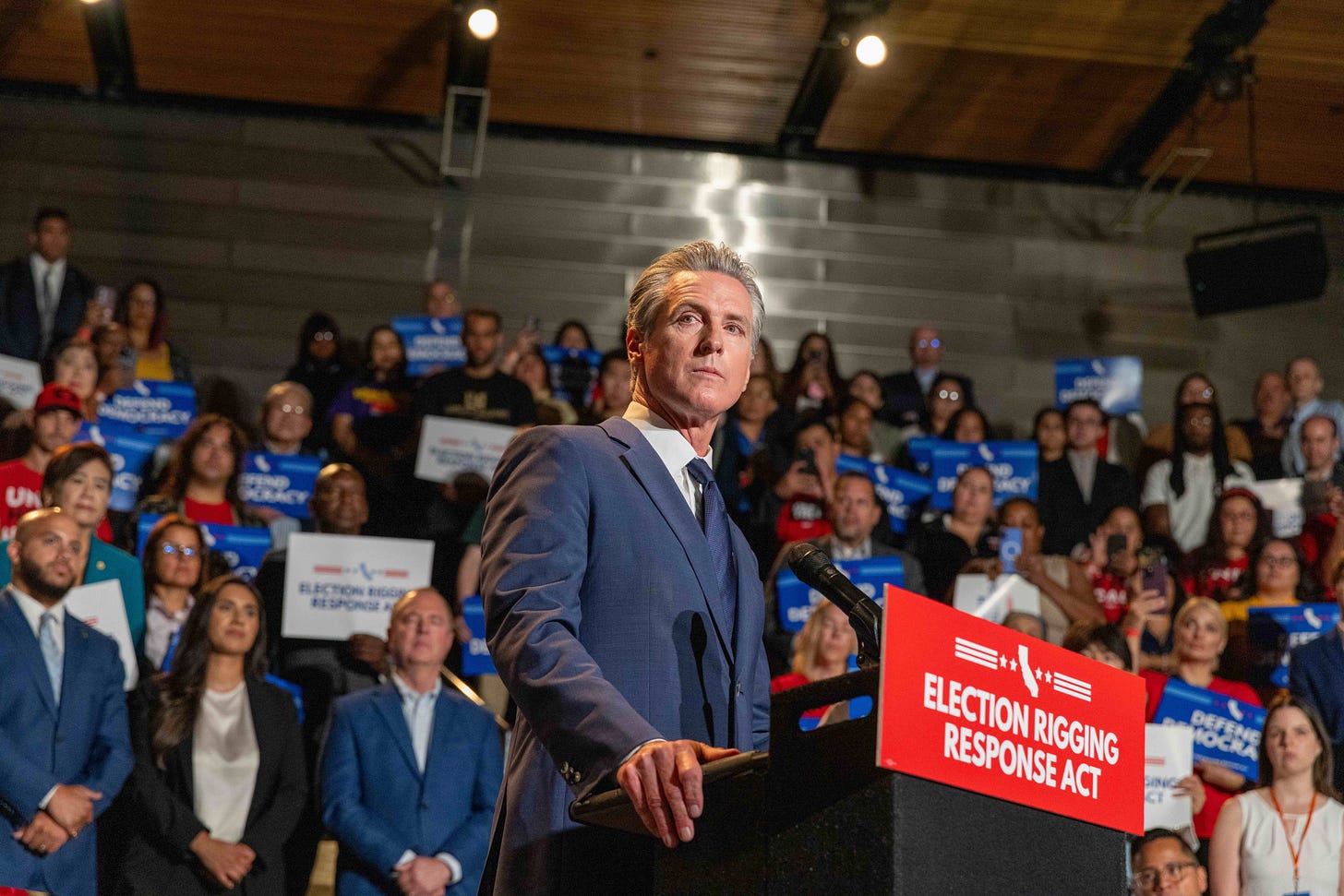The Liberal Populist Path
What Newsom Could Do If He Has the Courage
Gavin Newsom signed SB 79—a transit-oriented housing bill that overrides local obstruction to force construction near public transportation. Combined with dozens of other housing reforms, he’s using state power to break the homeowner cartels that have made California unaffordable for working people.
This isn’t mere incremental reform. This is structural combat: using democratic authority to subordinate rentier interests to collective need. Wealthy suburbs that block apartment construction to protect property values are being told their preferences don’t override everyone else’s need for housing near jobs.
That’s liberal populism in practice. Not just “helping people” through expert-designed programs, but fighting concentrated interests that prevent broadly shared prosperity.
And it creates an opening—if Newsom has the courage to take it.
The Opening Is Real
Trump’s authoritarian overreach plus Democratic establishment paralysis equals space for a Democrat who can credibly claim to be fighting both. Not as rhetorical positioning but as demonstrated practice.
Newsom didn’t create this opening. Trump created it by deploying ICE to sporting events, conducting warrantless mass detentions, and treating the Constitution as obstacle to be eliminated. Congressional Democrats created it by responding with careful statements, sophisticated analysis, and absolutely no willingness to fight power with power.
But Newsom positioned himself to exploit it. He’s providing moral witness—clear denunciation of federal violations without equivocation. He’s delivering material wins—housing, climate policy, healthcare at state level. He’s mounting institutional resistance—lawsuits, sovereignty assertions, using every tool of state power to block federal overreach.
This is the complementarity I’ve been arguing for: constitutional defense and economic populism. Moral clarity and structural reform. Resistance to authoritarianism and transformation of the structures that made authoritarian appeal possible.
Most Democrats do one or the other. Newsom is positioned to do both. The question is whether he recognizes what he has—and whether he’s willing to extend the logic beyond what’s comfortable.
What the Housing Win Actually Demonstrates
SB 79 isn’t just good policy. It’s narrative proof that liberal populism works when leaders have courage to fight concentrated interests.
Newsom can now say: “I fought local elites who wanted to protect their property values at the expense of working families. I fought NIMBYs in wealthy suburbs who think they should veto housing for teachers, nurses, farmworkers. I used state power to override concentrated interests blocking what everyone needs. And I won.”
This is what FDR did with economic royalists. This is what trust-busting looked like under Teddy Roosevelt. This is liberalism not as careful management of competing interests but as democratic power used to break concentrations that prevent markets from serving the common good.
But it only becomes presidential positioning if Newsom names the enemies he defeated. If he makes the fight visible. If he shows that delivering for working people requires fighting people with power—and being willing to welcome their hatred.
The technocratic version of this story is: “We passed comprehensive housing reform after careful stakeholder engagement and evidence-based policy design.” That’s the language of expert management. It treats citizens as beneficiaries of sophisticated analysis rather than as participants in democratic combat against entrenched interests.
The populist version is: “Wealthy homeowners wanted to keep California expensive so their property values would keep rising. They used local control to block apartments, condos, anything that would make housing affordable for everyone else. I told them no. They fought back. I fought harder. Now we’re building housing whether they like it or not.”
That’s the language of democratic power fighting economic power. It names enemies. It describes conflict. It shows that structural change requires structural combat, not just better analysis.
The question is whether Newsom will tell the populist story or retreat to the technocratic one. Whether he’ll fight or manage. Whether he’ll welcome hatred or seek consensus.
The National Extension: When Your Own Party Is the Obstacle
Here’s where it gets dangerous—and necessary.
The same pattern that plays out in California housing plays out in national Democratic politics. Local elites blocking construction to protect their interests. Establishment leaders blocking the structural fights that would actually deliver for working people. Careful analysis replacing courage. Consensus-seeking replacing combat.
Hakeem Jeffries and Chuck Schumer represent the old Democratic Party. The party that analyzes problems instead of fighting power. That seeks compromise with people who want to destroy constitutional governance. That treats working-class economic precarity as complication requiring expert management rather than as crisis requiring structural transformation.
They’re not villains. They’re not corrupt. They’re products of a system that taught them democracy works through careful positioning, sophisticated coalition-building, and trusting that competent governance will eventually be rewarded.
But that system is dead. It died somewhere between 2008’s financial crisis response that bailed out banks while abandoning homeowners, and 2016’s shocking discovery that working people would rather vote for a demagogue than for another round of expert management.
Jeffries and Schumer are still operating within the dead system’s logic. They think the path back to power runs through better messaging, improved candidate recruitment, waiting for Republicans to overreach so badly that voters have no choice but to return Democrats to power.
This is the analytical frame eating itself. More data about why Democrats lose. Better optimization of campaign strategy. All of it missing the fundamental problem: people don’t trust Democrats to fight for them because Democrats keep demonstrating they won’t fight the concentrated interests that need fighting.
If Newsom wants to build a presidential campaign, he needs to say this explicitly:
“Hakeem and Chuck are good people. But they represent the Democratic establishment that got us here. They’re obstacles to what needs doing—not because they’re bad, but because they’re still trying to win using frameworks that stopped working a decade ago.”
“I’m not asking them to resign. I’m asking them to fight. Really fight. Not just resist Trump—everyone resists Trump. That’s safe. That’s what donors expect. I’m asking: Are you willing to fight concentrated interests in our own coalition? Are you willing to tell wealthy donors their preferences don’t override working people’s needs? Are you willing to use democratic power to break economic concentrations, even when it makes your fundraising harder?”
“Because if you’re not—if you’re going to keep seeking consensus while the system collapses—then get out of the way and let someone who will fight actually try.”
This is the move FDR made. Not “I’m better than other Democrats.” But “I’m willing to fight the fights other Democrats won’t, and I welcome the hatred that comes from actually threatening power.”
Speaking to the Precariat
Think about who actually needs this fight. The thirty-two-year-old with a law degree working as a barista because legal hiring froze and never recovered. The software engineer doing gig work because “senior developer” jobs require ten years of experience with technologies that have existed for three. The couple with good jobs who’ll never own a home because housing prices rise faster than they can save.
These aren’t lazy people. They’re not asking for handouts. They did everything right—got the degrees, learned the skills, worked the jobs available. And they’re discovering that the system lied. That “work hard and you’ll succeed” was true for their parents but isn’t true for them. That they’re competing for scraps while wealth concentrates upward at speeds that make mockery of merit.
They don’t want another expert’s plan. They want someone who remembers what it feels like to need the next paycheck and not the next panel discussion.
Newsom can speak to this directly:
“The system is broken. Not because of immigrants or cultural change—because concentrated wealth has rigged it. Corporations demand experience for entry-level jobs because they’ve eliminated training programs to boost quarterly earnings. Housing costs explode because homeowners use local control to block construction. Student debt crushes because we treat education as individual investment rather than public good.”
“You know it’s broken because you’re living it. When experts tell you the data shows the economy is good while you’re struggling to afford rent—they’re not lying, they’re measuring the wrong things. GDP growth means nothing if it flows entirely to people who already have wealth. Stock market records mean nothing if you don’t own stocks.”
“The Democratic establishment keeps responding to your concerns with more analysis. Better white papers. Optimized coalition strategy. What they won’t do is fight the concentrated interests causing your precarity—because those interests fund their campaigns and determine who gets promoted within the party.”
“I’m not here to tell you I understand your pain. I’m here to tell you I’m willing to fight the people causing it. Even when they’re Democrats. Even when it costs me donors and makes me unpopular with people I used to have dinner with.”
“In California, I fought wealthy homeowners to force housing construction. I fought corporate interests on climate and worker protections. I fought establishment assumptions about what’s politically possible. And I’m winning—not because I’m smarter than other Democrats, but because I’m willing to fight concentrated power instead of managing it.”
“That’s what I’ll do nationally. Fight oligarchs rigging the economy. Fight corporate monopolies extracting wealth. Fight anyone who thinks their advantages matter more than your opportunity to build a decent life.”
The FDR Template
They said he was dividing the nation. He said, “I welcome their hatred.” That’s the template.
Franklin Roosevelt didn’t win by finding the perfect centrist position. He won by fighting concentrated wealth that had captured the system, building a coalition of everyone who worked for a living against everyone who lived off other people’s work.
He understood something establishment Democrats forgot: when the system is captured by concentrated interests, restoring democracy requires fighting those interests, not accommodating them. When inequality becomes extreme enough that ordinary people lose faith in democratic governance, you either fight oligarchy or surrender to fascism. There’s no third option of careful management.
Newsom needs this template. The structural dynamics are identical. Extreme inequality. Democratic institutions captured by concentrated wealth. Working people losing faith that the system can deliver for them. Fascist movements exploiting that loss of faith.
The establishment response is the same now as then: “Don’t be divisive. Don’t attack business. Don’t risk economic confidence. Find consensus. Wait for the opposition to overreach.”
FDR’s response was: Fight. Name enemies. Deliver material wins. Use democratic power to break economic concentrations. Build a coalition through combat, not through careful positioning.
That’s the path Newsom needs to take. He’s already started in California—SB 79 is him fighting homeowner cartels the way FDR fought economic royalists. The question is whether he’ll extend that logic nationally, whether he’ll make the fight explicit, whether he’ll welcome the hatred that comes from actually threatening power.
The Contrast: While Trump Builds Ballrooms
Trump has demolished the East Wing of the White House—the part Eleanor Roosevelt used for labor rights, where Lady Bird Johnson coordinated civil rights work—to build a 90,000-square-foot ballroom for oligarchs. Apple and Amazon are paying for it. Tech billionaires etching their names into the people’s house while gutting the architecture of public service.
This is what authoritarian spectacle looks like. Monuments to power. Palaces for tribute. Spaces designed for oligarchic performance, not democratic function.
While Trump builds ballrooms for billionaires, Newsom should be pouring concrete for housing workers can afford.
That’s the contrast. Not just different policies but fundamentally different visions of what government is for. Trump treats the presidency as performance space—spectacle, dominance, monuments to his own power funded by the oligarchs who captured the state. Newsom could treat the presidency as tool for breaking the concentrations that prevent shared prosperity.
One builds for show. The other builds for use. One celebrates power. The other serves citizens. One is monument to oligarchy. The other is instrument of democratic combat.
That contrast—made visceral through the image of Trump’s ballroom versus affordable housing—is more powerful than any policy white paper. It shows what the fight is actually about: whether government serves concentrated wealth or whether it serves everyone who works for a living.
Why the Establishment Will Fight Back—And Why That’s Good
Make no mistake: if Newsom takes this path, the Democratic establishment will fight him harder than they fight Trump.
Donors will object. Op-eds will condemn. Fellow Democrats will call him reckless, divisive, unserious. The people who staff congressional offices, run think tanks, write for major outlets—they’ll treat him like a threat to everything they’ve built.
Good.
If the establishment isn’t fighting you, you’re not threatening the structures that need disrupting. If wealthy donors are comfortable with your campaign, you’re not fighting concentrated wealth. If party insiders think you’re reasonable, you’re not challenging the frameworks that produced failure.
The safe path is what Kamala Harris did—seek consensus, avoid offense, let experts craft optimal policy, trust that competent management will win. The result: catastrophic loss to a fascist the second time around.
The safe path is what Jeffries and Schumer are doing now—careful positioning, waiting for Republicans to overreach so badly that voters have no choice. The result: continued decline, more losses, democratic collapse while we optimize our messaging.
Newsom needs to say this explicitly:
“I’m not taking the safe path. The safe path leads to more losses, more establishment management, more explanations for why we’re failing that somehow never include ‘we’re not willing to fight concentrated power.’”
“I’m fighting. I’m naming enemies—oligarchs, rentiers, establishment Democrats who’d rather preserve their comfortable positions than do what’s needed. I’m delivering material wins at state level and showing what national Democrats could do if they had courage.”
“And if I lose—if this doesn’t work, if voters reject it, if the establishment successfully marginalizes me—at least I’ll have tried something other than the approach that’s been failing for a decade. At least I’ll have fought.”
The Dare
“Hakeem Jeffries. Chuck Schumer. The entire Democratic establishment: I’m asking you directly—are you willing to fight?”
“Not fight Trump. Everyone fights Trump. That’s easy, safe, expected. I’m asking: Are you willing to fight concentrated interests in our own coalition? Are you willing to tell wealthy homeowners their property values matter less than housing affordability? Are you willing to tell corporate donors that worker power matters more than optimal business climate?”
“Are you willing to use democratic power to break economic concentrations, even when it makes fundraising harder? Even when it makes you unpopular with people you have dinner with? Even when it means choosing between your comfortable position and the structural fights democracy requires?”
“Because if you’re not—if you’re going to keep seeking consensus with people who want to destroy constitutional governance—then get out of the way.”
“The Democratic Party needs leaders who understand that restoring democracy requires fighting the concentrations of power that hollowed it out. If you can be those leaders, then lead. Show me I’m wrong about the establishment.”
“But if you can’t—if you’re going to keep analyzing why we lose without acknowledging that we lose because we won’t fight power—then step aside. Let someone who will actually fight have a chance.”
What This Requires From Newsom
This path demands more than rhetoric. It requires:
Sustained combat with California’s wealthy suburbs over housing enforcement. When Palo Alto sues to block SB 79, fight those lawsuits publicly, name the interests opposing affordability, welcome their hatred.
Open warfare with establishment Democrats who want consensus over combat. When Jeffries or Schumer criticize his approach, respond with clear explanation of why their framework has failed.
Material delivery that proves liberal populism works. Housing construction, healthcare expansion, climate policy—concrete wins that make people’s lives better.
Explicit class politics that names oligarchy as the enemy. Not “the wealthy” in abstract but specific: Elon Musk using wealth to capture government. Tech billionaires treating democracy as obstacle. Homeowner cartels blocking housing.
Presidential campaign built on fighting power, not on proving electability through careful positioning. The case isn’t “I’m most electable.” It’s “I’m the Democrat actually willing to fight—watch what I did in California, imagine what I’d do nationally.”
This is dangerous. This pisses off powerful people whose support Democratic politicians normally need.
But it’s also the only path that might actually work.
The Alternative Is Active Moral Failure
If Newsom doesn’t take this path—if he retreats to careful positioning and consensus-seeking—then 2028 may very well be 2024 again. Different candidate, improved messaging, same fundamental failure to offer something other than expert management of decline.
The establishment will keep analyzing why Democrats lose while refusing to acknowledge the answer: because they won’t fight the concentrated interests that need fighting.
Meanwhile Trump or his successor keeps building the fascist coalition by exploiting the vacuum Democrats created—the systematic evacuation of citizen agency, the replacement of participation with expert choreography, the precarity created by letting concentrated wealth rig the system.
If he flinches, it won’t be because fascism won. It’ll be because liberalism refused to fight back.
That’s not neutral. That’s not “taking the high road.” That’s active choice to let oligarchy and authoritarianism win because fighting them would be uncomfortable, would anger donors, would threaten establishment positions.
Managing decline is moral failure. Analyzing collapse while refusing to fight the forces causing it is moral failure. Treating democracy as complicated system requiring better optimization rather than as framework requiring defense through combat—that’s moral failure.
The choice is binary: Fight or surrender. There’s no third option of careful management that somehow navigates between oligarchy and democracy.
The Wire Still Holds—If Someone Walks It
I don’t know if Gavin Newsom is up to this. I hope he is.
Liberal democracy survives by maintaining the framework where progressive and conservative impulses can contest without force—but that framework only holds when leaders are willing to fight the concentrations of power that would capture it.
You cannot defend democracy through careful management of oligarchy. You cannot restore citizen agency through expert choreography. You cannot build democratic coalition by treating working people as problems requiring sophisticated solutions.
You defend democracy by using democratic power to fight concentrated economic power. You restore agency by letting citizens participate in structural combat. You build coalition by naming common enemies and delivering common wins.
Gavin Newsom has demonstrated he can do this in California. SB 79 is proof—he fought concentrated interests, used state power against local elites, delivered material wins for working people. He combined moral witness against federal authoritarianism with structural reform against economic concentration.
The question is whether he’ll extend that logic nationally. Whether he’ll fight his own party’s establishment the way he fought California’s homeowner cartels. Whether he’ll tell Jeffries and Schumer they’re obstacles and dare them to either join the fight or get out of the way.
Whether he’ll build a presidential campaign on fighting power—really fighting, naming enemies, welcoming hatred, delivering wins through combat rather than through consensus.
The opening is there. The path is visible. The framework is coherent.
All that’s missing is courage.
Two plus two equals four. There are twenty-four hours in a day. And liberal democracy cannot survive leaders who analyze power instead of fighting it.
The circus continues. The center needs holding. And holding it requires combat, not just careful positioning.
May courage carry him forward. Because without it, the analysis continues, the establishment keeps managing decline, and the fascists keep winning.
The liberal populist path is open.
If he has the courage to walk it.
Go Deeper into the Circus
The Elite Precariat: The Betrayed Class That Will Decide America’s Next Revolution
Something is breaking in America. But it’s not where everyone’s looking.







All. Of. This. As a Californian and a homeowner, I have learned to lean into SB-79 and to Newsom. Like FDR, he may not be perfect, but thank the gods, he's not afraid to throw a punch. I know the fear of every community left out of the original New Deal, especially with Newsom's flirtation with the podcast bros, is that we will somehow again be the disposable bargaining chip as Dems jockey for their next Savior. Still, we are the most pragmatic of all. If he shows up to fight, I am ready to rally behind him. Bring it on, pretty boy, you got this! BTW, as someone who worked in script development for many years, you wrote some damn good Newsom monologues there, Mike!
Thank you, thank you, thank you! My husband Whit Blauvelt (whose name you might recall) and I had a heated discussion about populism last night over dinner, prompted by the apparent implosion of Graham Platner's senate run in Maine. My argument was that if Democrats want to forge a liberal version of populism, we have to stop looking primarily to these stereotypical candidates -- people we think represent the working class -- but in practice who sometimes end up being not so progressive or even liberal (another case in point, John Fetterman). Whit seemed to be arguing that populism isn't even a very useful term for Democrats. I think you've shown precisely how it can be used, even if we don't explicitly say, "hey, here's a liberal populist for you!" Could an oyster farmer/former marine be a great candidate for office? Sure. But let's not let those demographics be our criteria or the things we latch onto as "electability." Look at the distinction between Cuomo and Mamdani in NYC. I think Mamdani represents the same things you are praising (hoping will come to fruition) in Newsom -- smart, educated, perhaps from an elite background, but willing to take on those elites. Cuomo has tried to smear Mamdani as just another elite. But look at who just got Adams's endorsement.